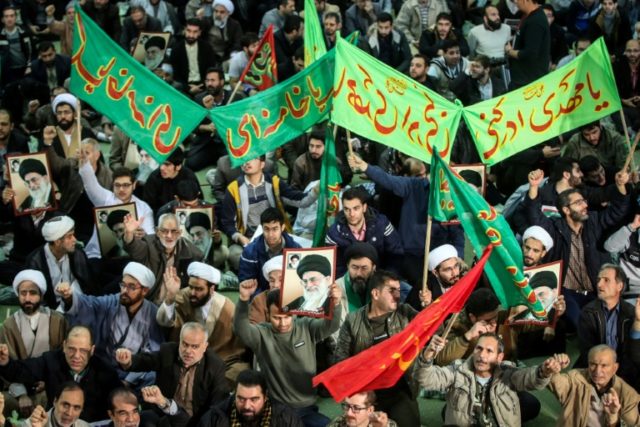TEHRAN, Iran (AFP) — Thousands of regime supporters marched in cities across Iran on Saturday in a show of strength for the regime after two days of protests that marked the biggest unrest in years.
State television showed large crowds of black-clad supporters gathering in the capital Tehran, second city Mashhad and elsewhere to mark the anniversary of the end of “the sedition” — the last major unrest that followed disputed elections in 2009.
It was a coincidence that the pre-planned rallies came just after anti-government protests, which had spread from Mashhad on Thursday to numerous towns across the country.
Initially aimed against high prices, the anti-government protests quickly turned against the Islamic regime as a whole.
Videos on social media showed hundreds marching through the holy city of Qom on Friday evening, with people chanting “Death to the dictator” and “Free political prisoners.”
Protesters in #Iran chant: “Clerics! Show some shame. Let go of our country.” #iranprotests #Islam pic.twitter.com/6Y8H7p3rwE
— Armin Navabi (@ArminNavabi) December 30, 2017
There were even chants in favor of the former monarchy toppled by the Islamic revolution of 1979, while others attacked the regime for supporting Palestinians and other regional movements rather than focusing on problems at home.
Footage of large-scale protests were shared from the cities of Rasht, Hamedan, Kermanshah, Qazvin and elsewhere, with police responding with water cannons.
“Alarm signal for everyone,” was the headline on reformist newspaper Arman, which called for action on living costs.
The conservative Javan newspaper warned that Iran’s “enemies are targeting the system’s popular support” and seeking to “create divisions.”
Trump warning
While state television focused entirely on the pro-government rallies on Saturday, officials nonetheless warned against dismissing the public anger seen in recent days.
“The country is facing serious challenges with unemployment, high prices, corruption, lack of water, social gap, unbalanced distribution of budget,” wrote Hesamoddin Ashena, cultural adviser to President Hassan Rouhani, on Twitter.
“People have the right for their voice to be heard.”
The US condemned the arrest of protesters, telling Tehran that “the world is watching.”
“Many reports of peaceful protests by Iranian citizens fed up with regime’s corruption and its squandering of the nation’s wealth to fund terrorism abroad,” President Donald Trump tweeted late Friday.
“Iranian govt should respect their people’s rights, including right to express themselves,” he wrote.
Since the 2009 protests were ruthlessly put down by the Revolutionary Guards, many middle-class Iranians have abandoned hope of pressing for change from the streets.
But low-level strikes and demonstrations have continued, often on a sector-by-sector basis as bus drivers or teachers or workers from specific factories protest against unpaid wages or poor conditions.
Some of this week’s protests were directed against financial scandals linked to unauthorized lending institutions which collapsed with the loss of hundreds of thousands of accounts.
There has also been anger at welfare cuts and fuel price increases in the latest budget announced earlier this month.
Since taking power in 2013, Rouhani has sought to clean up the banking sector and kickstart the economy, but many say progress has been too slow.
Although conservatives have fiercely criticized Rouhani for the country’s economic failings, they were already moving on Saturday to distinguish economic protests from wider attacks on the regime.
“The people who are protesting are vigilant and distance themselves from enemies of the system,” said Mohsen Rezai, former Revolutionary Guards commander, on his Instagram page.

COMMENTS
Please let us know if you're having issues with commenting.